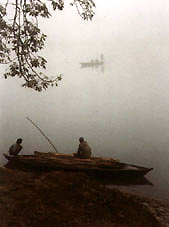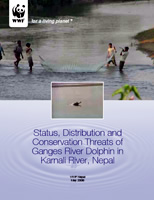 |
2006 |
|
 |
|
Nepal
has dolphins! UNDP helps communities conserve endangered species |
 |
Commonly known as 'Susu', Ganges River Dolphins are found in Nepal, Bangladesh,
India and Bhutan. Experts blame low political will and the absence of grass
root support as the key factors leading to this unique specifies facing
extinction today.
The
population of river dolphins are declining at a rapid rate of 10% annually.
"If present trends continue, there may be little time to save the vulnerable
Ganges River dolphins," says the World Wildlife Fund.
With
the help of UNDP, the Global Environment Facility, and the World Wildlife
Fund, more than 5,000 people recently joined a celebration organized in
Bhajani (Kailali district) by the Dolphin Conservation Centre, which was
aimed at raising awareness about the urgent need to protect this unique
native of Nepal.
In
between cultural shows and environmental messages, festival participants
learnt about local dolphin conservation efforts, like that of Mr. Bhoj
Raj Shrestha.
Several
years ago Mr. Shrestha started to collect catapults with the help of school
children. His message to the children was clear: "don't use catapults to
kill birds or hit leaping dolphins for fun". His efforts paid off. School
students started to collect catapults and tenderly nicknamed him, "Guleli
Baje", or catapult father.
The
villagers valued his work and soon began supporting his campaign. For him,
the conservation ethic is very simple: "conservation starts at home," he
says. True to his ethos, the 72-year old hunter-turned-conservationist,
has established the "Shrestha Private Forest" on his two hectare land.
Today, many egrets and herons come to roost safely in this oasis.
With
the help of the local kids and the villagers, Mr. Shrestha has collected
more than 3,000 catapults, saving the lives of countless birds and dolphins.
But even more so, Mr. Shrestha's catapult collection campaign has motivated
young people in the area to learn about the importance of conservation.
Source: UNDP
top
|
Karnali
river: Dolphin population endangered
|
 |
KATHMANDU,
Nepal, May 2006
 |
|
Sea
Dolphins
|
 |
| Six
months of field research conducted by WWF along Nepal's longer river, the
Karnali, shows that river dolphin populations are stagnant and remain more
endangered than ever.
River
dolphins are some of the most endangered of all the world's cetaceans and
at risk of extinction from habitat loss, hunting by humans, and naturally
low numbers.
Formerly
quite abundant, the overall population of Ganges river dolphins (Platanista
gangetica) is now probably fewer than 100 dolphins in Nepal, with the group
of about 20 in the Karnali River.
"Dolphins
in the Karnali face the threat of local extinction unless conservation
efforts are stepped up immediately," said Dr Chandra Gurung, WWF Nepal's
Country Representative. |
|
The
situation requires urgent action because dolphins, being at the top the
food chain, are indicators of a healthy aquatic ecosystem."
The
WWF Nepal study - Status, distribution and conservation threats of Ganges
River dolphins in the Karnali River, Nepal - is based on research conducted
on river dolphins in the Karnali River system in the western lowland of
Nepal from July 2005 to February 2006. The study will be discussed at a
two-day regional meeting on the conservation and management of river dolphins
in Asia, being held in Kathmandu, Nepal, from 26-27 May 2006.
top
|
Status,
Distribution and Conservation Threats of Ganges River Dolphin in Karnali
River
|
 |
WWF
Nepal Karnali River dolphin report
This
report, "Status Distribution and Conservation
Threats of Ganges River Dolphin in Karnali River, Nepal",
is an important milestone in WWF Nepal's commitment not only to conservation
of a flagship species but also to the needs of people, who like the river
dolphin, are dependant on freshwater resources. The research conducted
in the Karnali River is the first for aquatic fauna that the Freshwater
Program at WWF Nepal has undertaken since its inception in October 2004.
This report is an outcome of the research. There has been a drastic decline
in the status and distribution of river dolphins in Nepal. In the Karnali
River, dolphins face the threat of local extinction unless conservation
efforts are stepped up immediately. The situation requires urgent action
because dolphins top the food chain and are indicators of healthy aquatic
ecosystem. Their decline indicates the degrading quality of water resources
and is a warning to use our water resources more wisely.
Economic
development usually exerts tremendous pressure on environmental stability.
The aquatic biodiversity of Nepal has not escaped unscathed from the effects
of the irrigation and transport sector. Water diversion projects and the
construction of roads, dams, and bridges have degraded the habitat of river
dolphins. Before more damage is done, Nepal must strive to balance economic
development with the integrity of the environment.
WWF
Nepal, with the financial support of WWF UK, conducted this research and
was able to secure further funding from Swedish International Development
Agency (SIDA) / WWF Sweden / WWF International to carry out conservation
activities at field level.
I
hope it guides interventions to ensure a future for river dolphins in Nepal.
Chandra
P. Gurung, Ph. D.
Country
Representative
WWF
Nepal Program
 |
1.
INTRODUCTION 1
1.1
Background 1
1.2
Objectives of the Study 2
2.
STUDY AREA 3
2.1
Geruwa River 3
2.2
Mohana River 3
2.3
Limitations of the study 4
3.
METHODOLOGY 5
3.1
Reconnaissance surveys 5
3.2
Key informant survey and local consultations 5
3.3
Population survey 5
3.4
Mapping of prime habitats and distribution range 6
3.5
Data analysis 6
4.
RESULTS AND DISCUSSION 7
4.1
Status 7
4.1.1
Geruwa River 7 |
4.1.2
Mohana River 8
4.2
Distribution 8
4.2.1
Geruwa River 8
4.2.2
Mohana River 11
4.3
Threats and Issues in Dolphin Conservation 13
4.3.1
Prey depletion 13
4.3.2
Population Segregation 14
4.3.3
Habitat Degradation 15
4.3.4
Pollution 16
4.3.5
Trans Boundary Issue 17
4.3.6
Policy Issues 18
4.3.7
Awareness 19
5.
RECOMMENDATIONS 21
5.1
Policy 21
5.2
Specific Recommendations 22
5.3
Further Research 23 |
|
Source: WWF 2006
|






